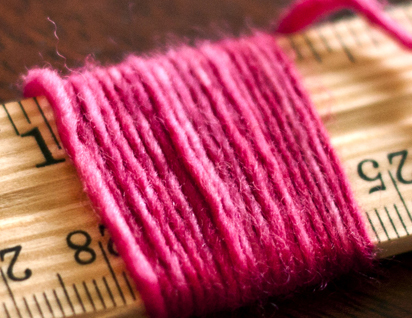A common issue with hand-dyed yarns is that it’s sometimes very difficult to get two matching skeins, even if they came from the same dye pot. The first time I encountered this was when I was shopping at the yarn store in which I worked. We had some lovely hand-dyed sock yarn from a fairly well known company in stock, and I wanted to order a few more skeins of the same color for a larger project. When we got the shipment of new yarn, I was surprised to see a very noticeable difference in the two lots; the first lot I had ordered from was a darker red with orange and green while the second lot was a slightly lighter red with more orange and yellow and green. Both were beautiful, and I could easily understand how they are considered the same colorway. I also noticed that I saw minor differences in shade throughout the dye lot; some skeins were a little darker while others had the fall colors more evenly distributed. For that project, I chose skeins that were the most similar to each other, and was able to create a beautiful scarf with multiple skeins of hand-dyed yarn.
I now have the pleasure of being on the other end of the market, and I see exactly why and how hand-dyed yarn can end up with a bit of variety in each pot. There are an incredible amount of different factors that go into how a skein looks by the end of the dyeing process. The yarn takes dye differently depending on where it is sitting in the pot, how close it is to the heat source, the different chemicals that are added, at what time the different chemicals are added, how much water the yarn is floating around in, the pH of the water, other chemicals in the city water we use, and the phase of the moon. (Obviously the moon phase has little to do with dyes, but the underlying point is that there will always be an element of randomness to it, even with the best laid plans.) So what can we do about this issue while making our projects? We can alternate skeins!
I’m not going to beat around the bush with this issue: alternating skeins is a pain. It takes forethought, extra winding of yarn, and it means that you have to carry more yarn with you if you’re traveling with your project (and don’t forget the occasional untangling). On the other hand, if you don’t alternate skeins when it’s needed, it can mean that you will not be happy with your finished project that you spent hours carefully working on. Why risk disappointment?
I’ve recently been preparing to make a sweater, which requires around 6 skeins of Norwegian Elkhound yarn. Even when they were hanging to dry, it was noticeable that there were variations between the different skeins.
Skeins of Norwegian Elkhound In Running Dog Nebula drying after being dyed.
After the skeins are wound, it’s easier to tell which skeins have the most contrast to each other; Some are more pink while some have a little bit more blue in them.
When the skeins are wound into center-pull balls, it's easy to compare how the colors will be distributed. You can see the bottom right skein is slightly more blue than the rest.
If we were to knit the two most contrasting skeins next to each other in a project, we would be disappointed in the result because it’s very obvious about where the first skein ends and the second skein begins. By alternating the skeins, even with the stark difference in the first swatch, it’s difficult to tell that the skeins were all that different to begin.
The obvious half-way line shows where one skein ends and another begins.
It's difficult to tell that there are two different skeins being used because the colors are distributed more evenly.
How do I alternate skeins?
To alternate skeins, you will need to have two skeins of yarn from which you are ready to knit or crochet. If you’re making a flat project, work two rows, one row for the front and one row for the back with the first skein. If you’re making on a project in the round, work only one row instead.
Once you have worked back to your starting point, drop the yarn from the first skein and pick up the yarn from the second skein, leaving a six inch tail to weave in at a later time.
Work one/two rows until you return to the starting point, and drop the yarn from the second skein. Pick up the first skein and repeat switching back and forth until you are done with your project.
Crude drawing of proposed alternating skeins method
If you’re working on a larger project, like the sweater I’m planning on making, you can start off working more than just one or two rows from the first skein so that the changes between the skeins are more gradual. I plan on knitting with about half the first ball before I start alternating with the second skein so that I won't suddenly have to switch from one set of two skeins to another set of two skeins mid project.
When is alternating skeins necessary?
Alternating skeins isn’t needed all the time with multiple skein projects. If you have two skeins of yarn that appear to match identically, it may not be worth the effort to alternate them. However, with hand-dyed yarns, alternating skeins is always the safest course of action to make sure that you won’t have to redo your project, or worse, hate your project when it’s finished.
















